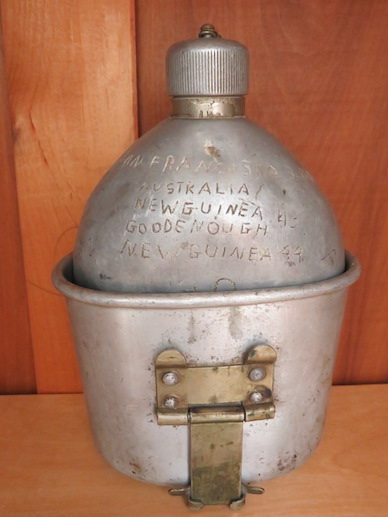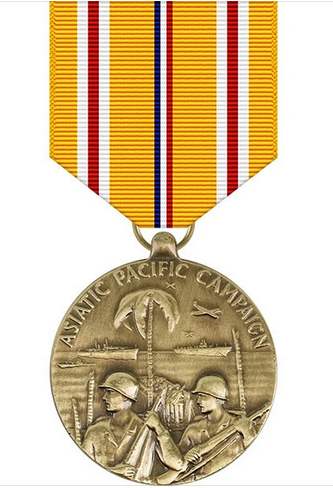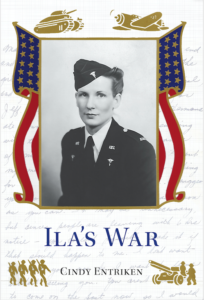Back in 2014, I started looking for materials about New Guinea. This was before I found James Campbell’s excellent book, The Ghost Mountain Boys, about the 32nd Infantry Division, the Red Arrow Men. The 32nd Infantry Division fought the Japanese across New Guinea and started the drive to push the Japanese troops back to their homeland. (1) I needed information about those battles because their Australian home was Camp Cable, where my great Aunt, Ila Armsbury, was stationed during WWII as an Army nurse. (For more information about Camp Cable, go to https://cindyentriken.com/2013/11/researching-ilas-war/) It was during my search for information about New Guinea I came across an unusual artifact — a used military canteen and cup with the name “Nicholas” inscribed on one side of the cup. I was intrigued and my first thought was, “I wonder if Nicholas is a first or last name?”
Who was Nicholas?

Below is a photo of the canteen inside the cup. The inscription of locations and dates was obvious. Still I couldn’t place the canteen until I pulled it out and looked at it more closely.
A Road Map for the 32nd Infantry Division

I knew immediately that the canteen was used during WWII because of its appearance, and the inscription “New Guinea 43”. I started reading the rest of the inscriptions . . . San Francisco 3-30-44, Australia, Goodenough, New Guinea 44, Port Moresby. All those names and dates were on just one side of the canteen. The more I read the more excited I became because I recognized those locations and dates — I was holding a canteen with a recorded history of the road map of the 32nd Infantry Division.
A Connection to My Aunt – Ila Armsbury
But it wasn’t until I turned the canteen over and read the place names and dates on the other side that I knew the universe had given me an amazing, serendipitous gift.
Because at the bottom of a list of places were the words — Camp Cable.

Even now I am amazed that of all the WWII canteens available in all the military surplus stores around the world, I should find one canteen inscribed with the words Camp Cable. Honestly, there is no other explanation except that the universe was helping me as I struggled to write Ila’s War.
Other locations and dates on the Camp Cable side of the canteen were: Camp Roberts, Fort Ord, Woodside, (2) Alia, Nicholas, Waubaue 2-24-44, Adelaide 5-14-42, Melbourne, Sydney, and Brisbane.
The bottom of the cup was inscribed with the initials of the manufacturer and the date the canteen and cup were made: 1918. I knew from earlier reading that many American soldiers started their service in WWII carrying surplus equipment from WWI. (3)

Five companies manufactured canteens for WWI, including, the Aluminum Company of America (ACA), Aluminum Goods Manufacturing Co. (AGM Co), Buckeye Aluminum Co. (BA CO.), the J. W. Brown Manufacturing Co. (T.J.W.B.M.CO.), and Landers, Frary & Clark (L F & C). The government specified “that the letters U. S., the name or symbol of the company and the year of manufacture be stamped either on the bottom of the cup or on the top of the handle.” (4)
G N?
But as I stared at the bottom of the cup, I noticed other etchings so I turned the cup upside down and saw this:

Those letters, G N told me that Nicholas was the last name – another clue I could use to figure out who owned the canteen and cup during the war.
George Nicholas — The Oklahoma Outlaw
Where to start to identify the man who carried this canteen? Thankfully I had more hints because G. Nicholas had also etched onto the canteen the words Skedee Okla, Pawnee, Okla Outlaw and Fort Sill 1-10-42. With the help of Dodie O’Bryan, president of the Pawnee County, Oklahoma Historical Museum I was able to identify G. Nicholas as George Nicholas. His photograph and a brief statement of his background were in a book, The Men and Women in World War II from Pawnee County, owned by the museum. Sadly, no author is identified in this book.


Pfc. George M. Nicholas, son of Mr. and Mrs. M. T. Nicholas, Skedee, attended Morrison high school. Entered Army 1942; trained at Camp Roberts, Calif. Served in SW Pacific. Awarded Asiatic-Pacific Campaign Medal, Distinguished Unit Citation, 2 bronze stars, 3 arrowheads, Discharged 1944.
I finally understood the reference to Camp Roberts. According to the camp’s website it was one of the largest military training sites in 1941 and “hosted an Infantry Replacement Training Center and a Field Artillery Replacement Training Center. . . . Over 436,000 troops passed through an intensive 17-week training cycle.” (5)
Pfc. George Nicholas was one of the replacement troops assigned to the 32nd Infantry Division before it even left the States for Australia in the spring of 1942. Perhaps because of the caution to troops about writing home with information about their locations he used his canteen as a sort of diary to record places and dates he was stationed.
Medals and Ribbons
Below are pictures of each of the awards Nicholas received and an explanation for each award.

Asiatic-Pacific Campaign: This Medal was awarded for qualifying service between December 7, 1941, and March 2, 1946. Criteria: The Asiatic-Pacific Campaign Medal was awarded for for qualifying service within the Asiatic-Pacific Theater of Operations between December 7, 1941, and March 2, 1946, under any of the following conditions: On permanent assignment within the Asiatic-Pacific Theater; or, For service in a passenger status or on temporary duty for 30 consecutive days or 60 non-consecutive days; or, For service in active combat in the Asiatic-Pacific Theater of Operations against the enemy and awarded a combat decoration or furnished a recognition by the commanding general of a corps, higher unit, or independent force that the individual actually participated in combat. (6)
 The Distinguished Unit Citation was established by Executive Order No. 9075, on 26 February 26th 1942. This order made it possible for the Secretary of War to issue citations in the name of the President of the United States to units of US Armed Forces and their Allies for heroism in action against an armed enemy from December 7th 1941 onwards. The unit must display such gallantry, determination, and esprit de corps in accomplishing its mission under extremely difficult and hazardous conditions as to set it apart and above other units participating in the same campaign. This act should be equal to that of an individual who could obtain the Distinguished Service Cross for it. The design was approved on May 30th 1942. . . . The decoration was renamed to the Presidential Unit Citation on November 3rd 1966 and can still be obtained for actions in the past. (7)
The Distinguished Unit Citation was established by Executive Order No. 9075, on 26 February 26th 1942. This order made it possible for the Secretary of War to issue citations in the name of the President of the United States to units of US Armed Forces and their Allies for heroism in action against an armed enemy from December 7th 1941 onwards. The unit must display such gallantry, determination, and esprit de corps in accomplishing its mission under extremely difficult and hazardous conditions as to set it apart and above other units participating in the same campaign. This act should be equal to that of an individual who could obtain the Distinguished Service Cross for it. The design was approved on May 30th 1942. . . . The decoration was renamed to the Presidential Unit Citation on November 3rd 1966 and can still be obtained for actions in the past. (7)

There are three types of Bronze Star Medal: Achievement, Merit or Valor.The Bronze Star Medal is awarded to any person who, after December 6, 1941, while serving in any capacity with the Armed Forces of the United States, distinguishes himself or herself by heroic or meritorious achievement or service, not involving participation in aerial flight. (6)

The Arrowhead Device is a bronze award bestowed by the United States Army to be worn as an attachment to specific service medals. It is awarded to personnel who have been a part of a combat parachute drop, a combat glider attack, a helicopter assault landing or an amphibious assault. (8)
So I solved the mystery of who owned the WWII era canteen and cup I found at a local military surplus store. Sadly, there are still a couple of places I can’t identify: Alia and Waubaue 2-24-44. Do you know? If so, please drop me a line so I can tell everyone else. And thanks for reading this blog.
For More Information
I found The Ghost Mountain Boys to be the most insightful in helping me understand what happened on New Guinea. But there are other sources that you might like as well. Below is a list of additional sources including first-hand accounts.
- The 32nd Infantry Division In World War II, by Major General H. W. Blakely. This book was originally published in 1955. My copy was printed by Battery Press in Nashville but it lacks a publication date.
- My Unforgettable Memories of World War II, by Jesse M. Coker, ED.D., Book Crafters, 1994.
- Baseball, Battle, and a Bride (An Okie in World War II), by James Bement. Trafford Publishing, 2009.
- 13,000 Hours: Combat History of the 32nd Infantry Division, World War II, by the Public Relations Office, 32d Inf. Division, printed by 2773rd Engrs. publication date unknown.
- Diary of a National Guardsman in World War II, 1940-1945, by Clarence Jungwirth. Poeschl Printing Co., Inc. 1991.
Sources
(1) To learn more about The Ghost Mountain Boys, go to http://www.ghostmountainboys.com/ (accessed 4/6/2020).
(2) https://www.ozatwar.com/ozatwar/campsandcreek.htm (accessed 2/27/2020)
(3) https://history.army.mil/html/books/010/10-12/CMH_Pub_10-12-1.pdf ( pg. 172, accessed 3/24/2020)
(4) https://olive-drab.com/od_soldiers_gear_canteen_cup.php (accessed 3/20/2020)
(5) https://camprobertshistoricalmuseum.com/history-of-the-base/ (accessed 2/27/2020).
(6) http://www.americanwarlibrary.com/personnel/bronze.htm (accessed 3/3/2020)
(7) https://www.tracesofwar.com/awards/838/Distinguished-Unit-Citation—Army.htm
(8) (https://www.usamilitarymedals.com/products/bronze-arrowhead (accessed 2/28/2020)


Loved reading this, Cindy. Admire your research and tenacity.
M.Litton
Thanks, Melvin. I appreciate your comment. Originally I had hoped my book would be published and available by Memorial Day but that’s not happening now with the virus interrupting life as we know it. But it is being published and I’ll let you know when it’s available. Take care and stay well.